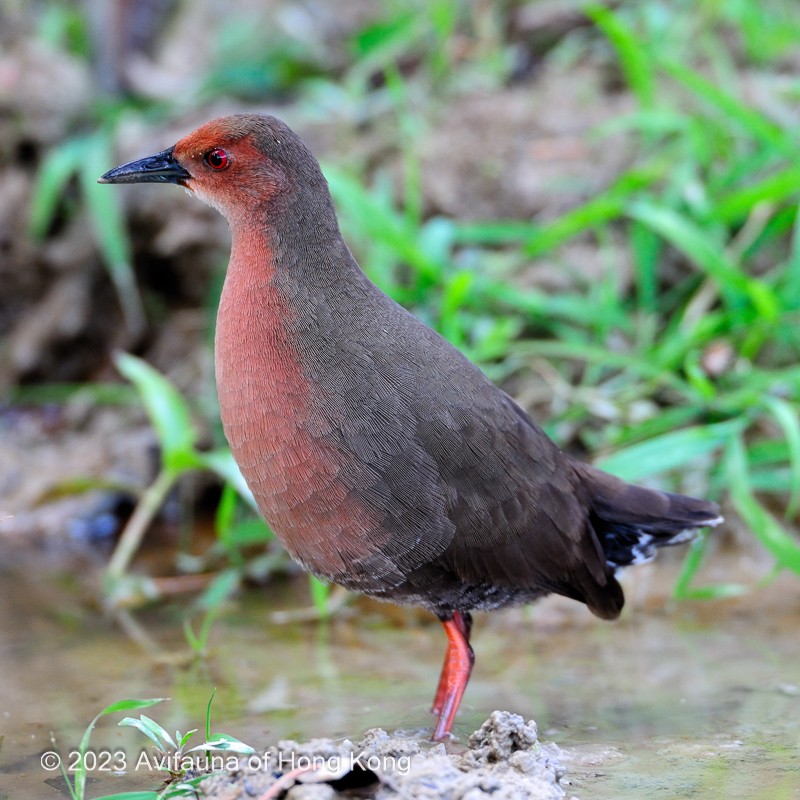Ruddy-breasted Crake Zapornia fusca 紅胸田雞
Category I. Scarce passage migrant and winter visitor to densely-vegetated freshwater marsh areas.
IDENTIFICATION

Nov. 2013, Kinni Ho.
21-23 cm. Dumpy, medium-sized rail with short dull grey bill. Adult has dull cold brown upperparts and flanks, orange-brown forehead, deep reddish cheeks, throat, chest and upper belly, dark grey-brown vent and undertail coverts with irregular and widely-spaced white bars. Deep red legs and feet, dark grey bill. Sexes alike but female generally paler with whiter throat.

Oct. 2020, Michelle and Peter Wong.
Immatures are noticeably duller than adults and have very little rusty colour on the underparts. Moult into an adult-like plumage appears to be complete by early winter (Taylor and van Perlo 1998), and so such birds are rarely seen in HK.
VOCALISATIONS
The song is a distinctive increasingly fast series of moderately high-pitched notes. Lower-intensity variations of this are given in the non-breeding season.
Other vocalisations include a rapidly uttered series of notes that trails off and falls in pitch and a slightly nasal series of notes; one or both of these are presumably used in alarm.
DISTRIBUTION & HABITAT PREFERENCE
Most records are from the northwest New Territories, mainly the extensive areas of freshwater marsh at Mai Po NR and Long Valley. It has also occurred at other sites in the New Territories and on Lantau, and there are records of migrants on Po Toi. Occasionally birds are recorded at atypical urban sites, sometimes injured or dead; one remained at Telford Gardens, Kowloon Bay for two weeks from 23 October 2020.
Most sightings are of individuals foraging at the edge of thickly vegetated, freshwater or brackish wetlands and wet agricultural areas, especially fallow or disused parts. There have been several records of birds found, sometimes incapacitated or dead, in urban areas.
OCCURRENCE
A scarce passage migrant and winter visitor, this species appears to be the most commonly occurring small migrant crake in HK, although an increased frequency of records compared with last century is considered due to increased observer activity.
In autumn the earliest on record occurred on the exceptional date of 9 August 2008, with the next earliest present on 8 September 2016. Considering Vaughan and Jones’ (1913) observation that this was a summer visitor to the region, the August record may best be regarded as just that.
Figure 1 indicates that numbers gradually increase to the third week of November, presumably due to passage birds occurring. Thereafter, there is evidence that birds settle into winter territories, with some individuals then noted almost daily at certain sites where they may become more confiding, or where observers become attuned to their habits and able to locate them more easily. These winter territories may be maintained until around the middle of March, although numbers appear to decrease from mid-February.
The peak day count is five at Mai Po on 8 January 2012. An increase in records in the second week of April indicates weak passage, though it is rare after the middle of the month, with the latest spring record concerning one on Po Toi on 12 May 2012.
Vaughan and Jones (1913) stated that it was a summer visitor to the region (see under Breeding). Dove and Goodhart (1955) reported one near Fanling on 2 October and two near Luen Tak on 11 October, both in 1953.
BREEDING
Although there are no records in Hong Kong, Vaughan and Jones (1913) recorded Ruddy Crake breeding at Macau and Sam Shui, with nests or eggs found from 13 June to 21 September.
BEHAVIOUR, FORAGING & DIET
Generally secretive and retiring, confining itself densely-vegetated marsh.
RANGE & SYSTEMATICS
Breeds from southern Ussuriland and northern Japan south through east Asia and south China to the Philippines and Indonesia and west to through much of Indochina to northern and southwestern areas of the Indian subcontinent to Sri Lanka; northerly populations migratory (Taylor and Kirwan 2020). Liu and Chen (2021) indicate that in China it mainly breeds only as far north as Hebei and southeast of a line from there to Yunnan, with northerly populations migratory.
Four subspecies are recognised, of which Z. f. erythrothorax is presumed to occur in HK as it breeds from southeast Siberia through northeast China to Korea, Japan and Taiwan. Some sources suggest the taxon Z. f. phaeopyga is not restricted to the Ryukyu Islands in Japan, but also includes birds breeding in Taiwan and even east China (Taylor and Kirwan 2020, Brazil 2008).
CONSERVATION STATUS
IUCN: Least Concern. Population trend decreasing.
Figure 1.

Dove, R. S. and H. J. Goodhart (1955). Field observations from the Colony of Hong Kong. Ibis 97: 311-340.
Taylor, B. and G. M. Kirwan (2020). Ruddy-breasted Crake (Zapornia fusca), version 1.0. In Birds of the World (J. del Hoyo, A. Elliott, J. Sargatal, D. A. Christie, and E. de Juana, Editors). Cornell Lab of Ornithology, Ithaca, NY, USA. https://doi.org/10.2173/bow.rubcra1.01
Taylor, B. and B. van Perlo (1998). Rails. A guide to the rails, crakes, gallinules and coots of the world. Pica Press, U.K.
Vaughan, R. E. and K. H. Jones (1913). The birds of Hong Kong, Macao and the West River or Si Kiang in South-East China, with special reference to their nidification and seasonal movements. Ibis 1913: 17-76, 163-201, 351-384.
Liu, Y. and S. H. Chen (2021). The CNG Field Guide to the Birds of China (in Chinese). Hunan Science and Technology Publication House, Changsha.

